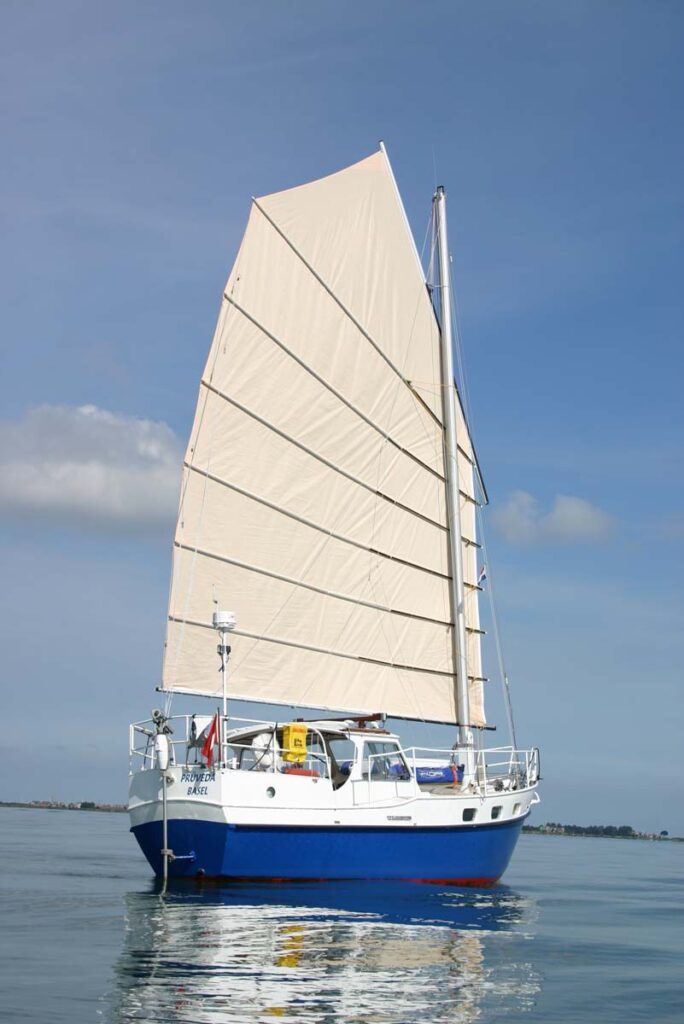1. Junk Rig Association Report August 2006 Newsletter 47
Written by Ursula & Wolfgang
The Converting & refit of „PRÜVEDA“
We live in Switzerland and have visited many countries, travelling by bicycle, because we like to move under our own power. When it was necessary to leave land, we always looked for an option to travel by sailboat and not by air. In this way we were using nature’s energy, something which is important to us. While we were sailing with an English family, from Ecuador to Key West USA, we read Annie Hill’s Book Voyaging on a small income. This is where we learnt, for the first time about junk Rigs and we became enthusiastic about the idea. As our passion for sailing developed, we came to the conclusion that our next journey would be with our own (Junk Rigged) sailing boat. We started in a small way, with a dinghy 420 in Switzerland. Whenever it was possible we went sailing with Ursula’s parents, who had owned a wonderful wooden sailboat for 15 years and lived on board for 7 years.
Finding the right boat
In 1998 we found a Dutch steel boat, very close to our home. It was a Gouwzee III designed by Pieter Beeldsnijder. The name „PRÜVEDA“ means cosiness in the Swiss mountain language Rhaeto-Romanic. We liked the name, and decided not to change it. The boat was in a very bad condition when we bought it, especially inside, but the hull looked strong, we liked the long keel and the shape of the raised deck. The former owner bought PRÜVEDA 1972 from a builder in Harderwijk.
She then came via the river Rhine to Switzerland, where she stayed for many years in the freshwater of lake Konstanz. She was a Bermudan rigged with a rotten wooden mast and boom. The fact, that the sails were 30 years old, made the decision easy, to convert PRÜVEDA into a Junk Rig boat.
It was never our ambition to build a hull ourselves; we had enough problems to manage the refit which took seven years. Our ’new‘ boat needed to be a cosy home, with enough room for the two of us and sleeping space for at the most two visitors. There had to be a large pantry, with a good stove and an oven, and we wanted to have heat in the living room and the bathroom in the bow. Most importantly we wanted an easy to handle sail plan hence the Junk Rig.
At first our knowledge of Junk Rigs was purely theoretical. To learn more, we travelled to England and visited Robin Blain in 1999. He took us out on his boat and demonstrated the use and advantages of a Junk Rig. After this trip we were absolutely convinced that the Junk Rig was what we needed. A few weeks later we received the rigging plans from Sunbird Marine.
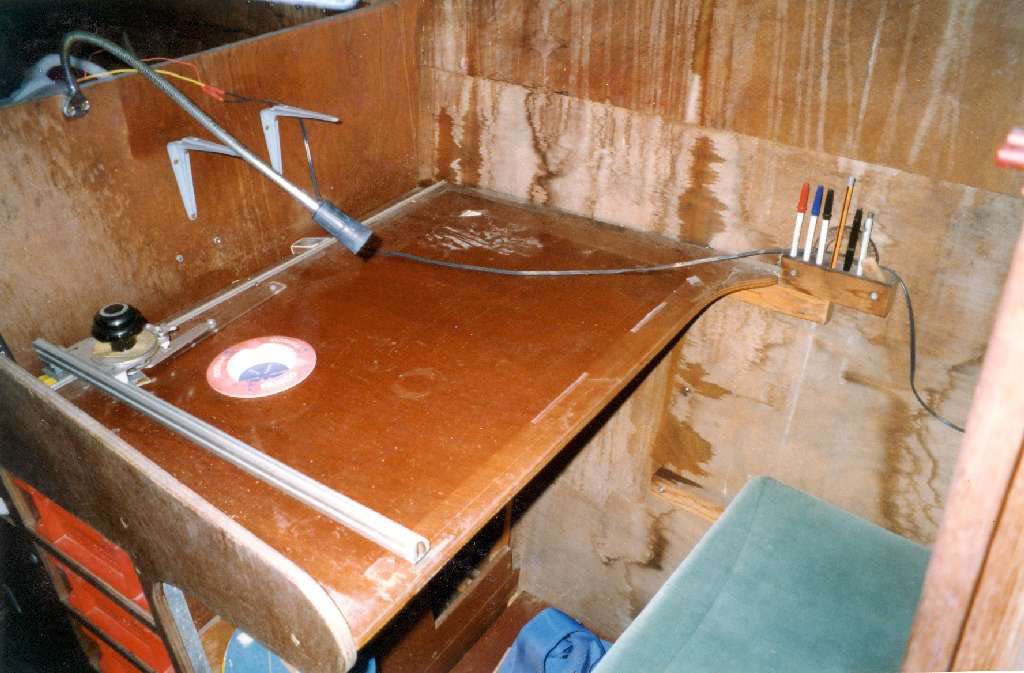

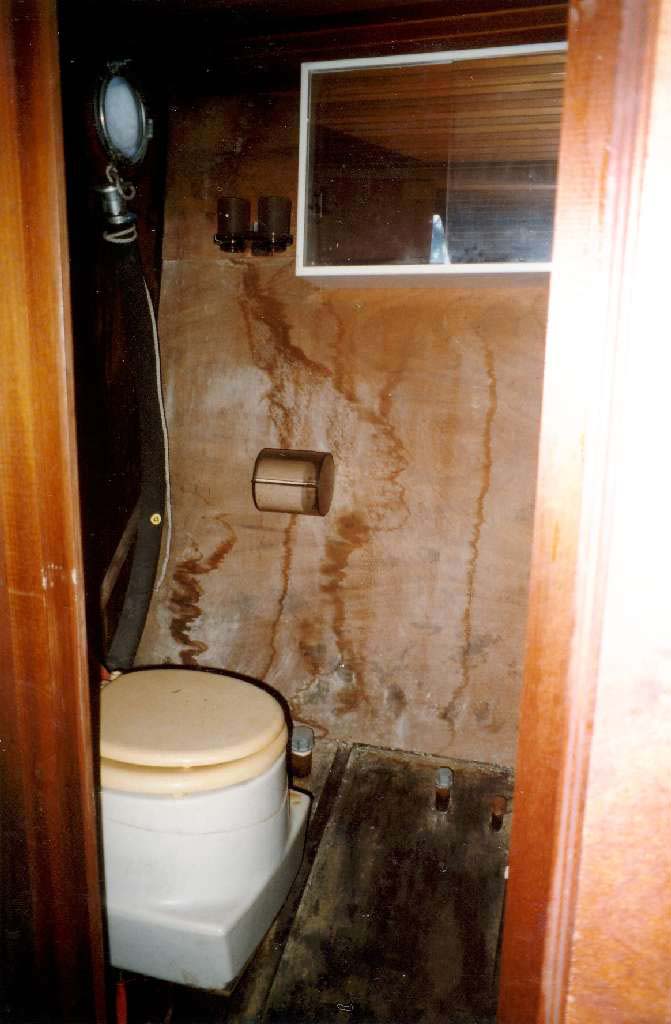
old Navitable/Pantry/Bathroom
The refit startet
The refit started in November 1998 and ended in July 2005 (except that work on a boat will never come to an end). When we started, we had a workbench next to the boat and a small, old building shed, to store materials and tools. The boat was standing outside on a trailer and after a rainy day, the engine bilge was always filled with water, a roof made of canvas improved the situation. First of all we removed the ‚furniture‘, the old engine, the steel tanks, the floor and last, the lead keel with a sledgehammer.

cleaning old bilge
Organizing the work
All the removed parts, that were still usable, like stove, lines, bull eyes, fenders, anchor winch, prop etc. were cleaned, recorded and stored in our big cellar at home. We designed and drew a new deck plan and a new interior layout. This was a long process with a lot of alterations and compromises. We also calculated the new weight distribution, as far as it was possible.
To plan a rough time schedule, we created several lists of summer and winter work. For example the three simple words: ‚insulating the hull‘ turned out to be four month work!
In the meantime we realized that the refit of PRÜVEDA would take far more time than two years, as we calculated in the beginning but needing more time is not always a disadvantage. It helps to buy expensive things (like a new engine) step by step. Mayor expenses don’t come in all at once. Meanwhile some general theories may turn out to be wrong and are changed during the building. If there is time, equipment may get cheaper and better parts become available, for example; the hinges in the batten of the Junk Rig, they didn’t exist at the time we started.
Steelwork
We soon realized, that the owner of a steel boat should have some knowledge of welding (at first we asked a friend to do it) but after attending a course and after many hours of practice, Wolfgang did the welding himself.
We changed the very small aft cabin with a new one. At that time we began to be unpopular with our neighbours, because we worked every evening until nine o clock. Our work place was not in a boatyard, and nearby there were a lot of apartment houses. We resolved these problems by keeping to agreed working hours. So the work went on and PRÜVEDA got a new steel tail, a new steel tabernacle to lower the mast and new windows on the pilothouse.
Painting
The hull and the pilothouse were sanded inside and painted three times with two component paint. In summer we removed the paint on the outside hull, piece by piece. After cleaning and sanding, the hull was painted with seven layers of two component paint. To get good access around the boat we used old scaffolding, it remained there until we did the antifouling.
Woodwork
We had access to a carpenter’s workshop. It was very helpful, for making the doors, tables, cupboards, etc, and to assemble the inside furniture. With a few hundred hours on the woodworking machines, Wolfgang almost became a carpenter himself. The old furnishings in PRÜVEDA were made of very expensive mahogany plywood; we were able to use it again after cleaning and sanding it. We were also lucky to get some used Merbeau wood (an expensive tropical wood from Madagascar) for free, to build the hatches.




building pantry
The insulation and interior
The insulation we used was white foam, made from recycled plastic bottles; it is not poisonous, does not takes up either water or humidity and is not easy to burn. On one side there was an adhesive with a protecting paper, once the foam was cut in the right shape, we simply removed the paper and fixed the foam with the double sided adhesive to the cleaned and dry hull. From the roof to the bilge every thing was insulated, even the engine room. To design the best layout for the interior, we made experimental furniture on a scale of 1:1 out of cardboard. They could be changed and moved easy and gave us a good idea of how the furnishings would function. For the walls and the furniture we used watertight Okumé Plywood. In our opinion there is not enough light in the cabins of small boats, so we painted the walls and the furniture white.
All the doors and the drawers were edged with Mahogany to compliment the white. Visitors are often surprised, at how big a small but light room can appear.

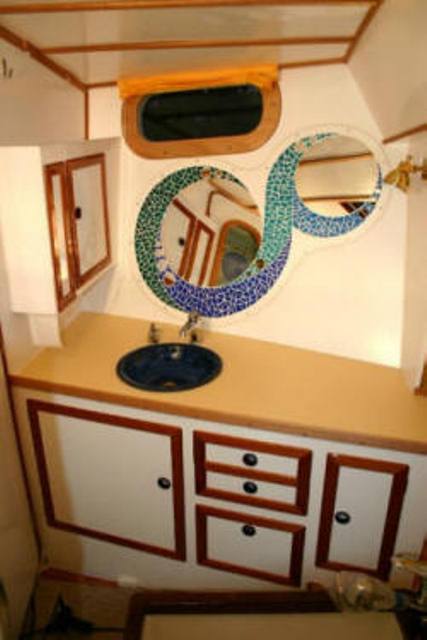
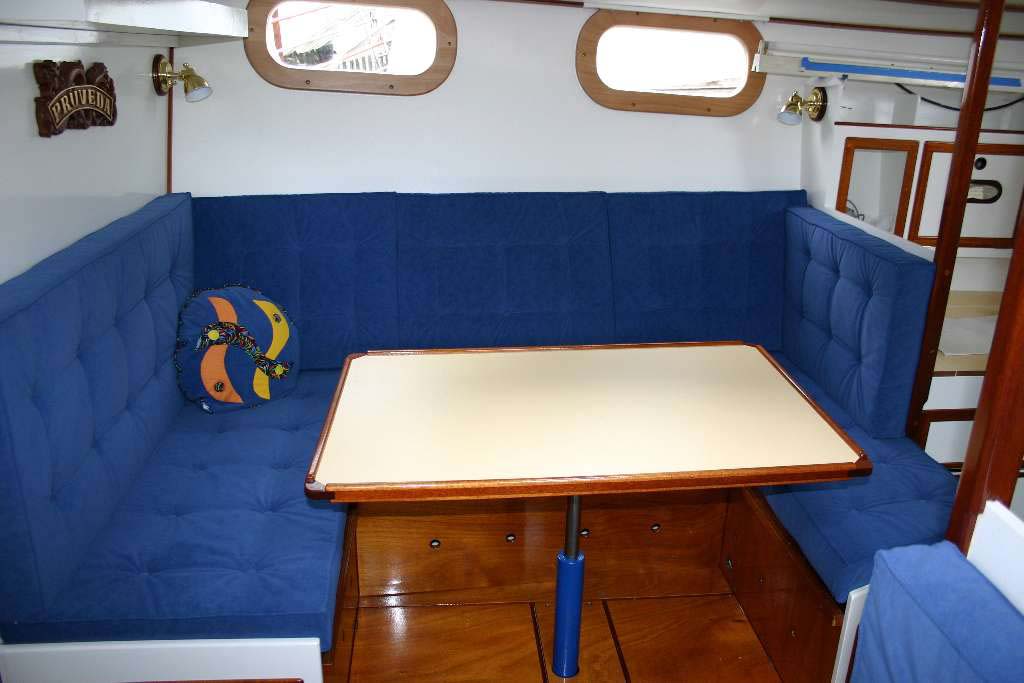
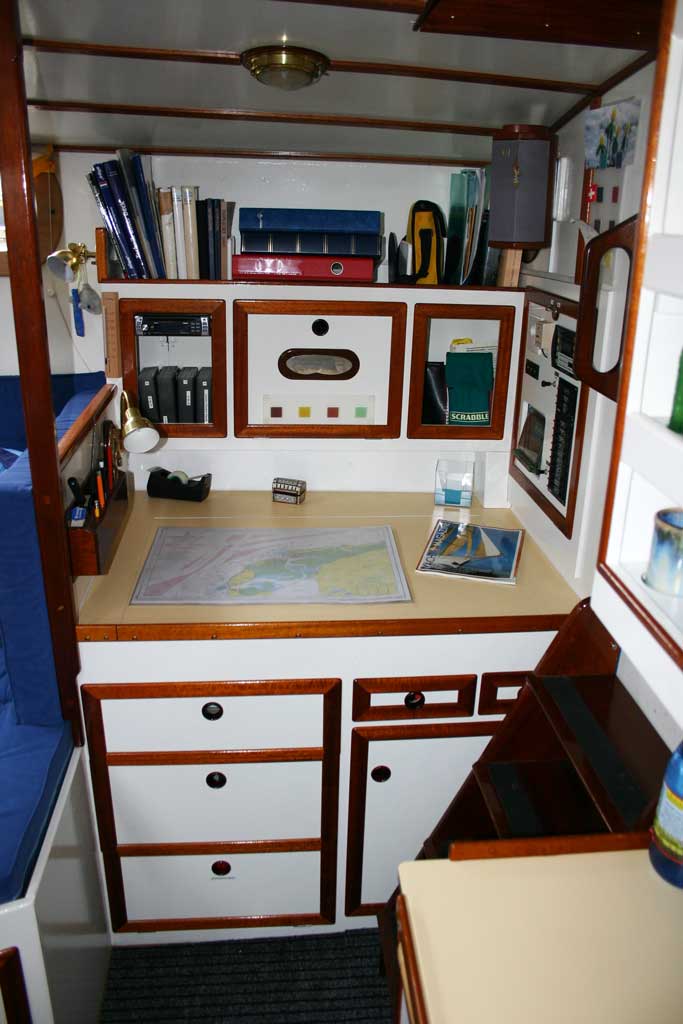
new Pantry/Bathroom/Livinroom/Navitable
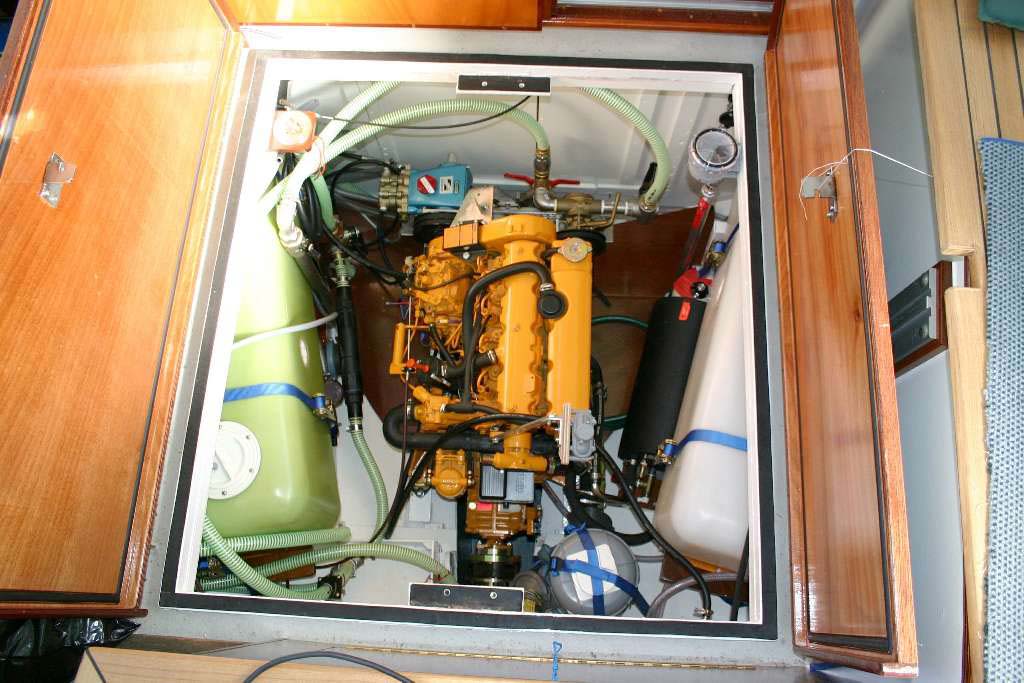
engineroom
Where to buy or get boat equipment
Switzerland is not a major sailing nation (with the exception of winning the America’s Cup) and suppliers of boat equipment tend to be rather expensive. The German market is much cheaper even with tax and transportation. We ordered many items at ‚Interboot‘ (boat show in Germany), where we had a larger selection and better discounts. We always tried to buy only things we could not make ourselves, so we saved a lot of money.
For example we re-cycled many thrown away materials, very useful welding parts for free, like stainless steel off-cuts or tubes. We also bought rolls of cloth and foam and Ursula sewed the upholstery with the help of her mother. We always tried to avoid buying delicate electronic equipments. Although we have to admit, using a GPS for safer navigation is helpful.
To decide what was worth buying and what was unnecessary, Ursula’s father was a big help. As a professional electrician and an experienced live aboard sailor, he made his knowledge available to us. Even so we ended up with more technology on board than we ever wanted.
The new Junk Rig
The aluminium mast was manufactured by a mast builder in Germany, together with the yard, the boom and the working battens. It took us quite a lot of effort to find a round aluminium mast. To cut a long story short, in a lot of Junk Rig reports we read sentences like: „We investigated motorway lamp standards, flag poles, telegraph poles to find a round mast for our junk Rig!“ We had the same problems finding a mast. We placed a fore stay from the top of the mast to the bow, which can be connected to the shear legs. Lowering the mast can be done by two people. We use the stay for the SSB antenna.
The design of our 47sqm Junk Rig Sail came from Sunbird Marine Services, the sail was manufactured by Chris Scanes. We have hinged (working) battens, round aluminium tubes connected with Delrin cones. At first we chose some very thin keep battens (10mm round polyester rod) this was a mistake; they turned out to be too weak. The Delrin cones destroyed the end of the working battens, and the sail took on a hard vertical edge, the shape was not a nice sight. Stronger PVC tubes were specified and so far they seem to be more successful, more testing will take place during the 2006 sailing season. All the control lines for the sail lead back to the pilothouse, the halyard runs over a self tailing winch hand powered by the energy of the skipper; he has to have daily fitness exercises. The sheets are lead over the aft cabin back to the cockpit; all lines are stored in the cockpit in open bags.

mast lowering
Pilothouse and spray hood
PRÜVEDA is a motor sailer with a half open pilothouse, protecting us from bad weather. A wooden beam is mounted on the roof, where the sail bundle is stored. GPS and Navtex Antennas, navigation lights and two solar panels are also located on the roof. At first, to have dry access to the aft cabin, we made our own spray hood in Switzerland. It worked well, but had many disadvantages, for example we had to climb underneath to reach the stern. In Holland where we stayed during the winter, we saw a lot of boats with professionally manufactured spray hoods. We therefore had plenty of references and could work out a better solution for our second spray hood, which Ursula made. Good advice and the support of a local sail maker was a great help.
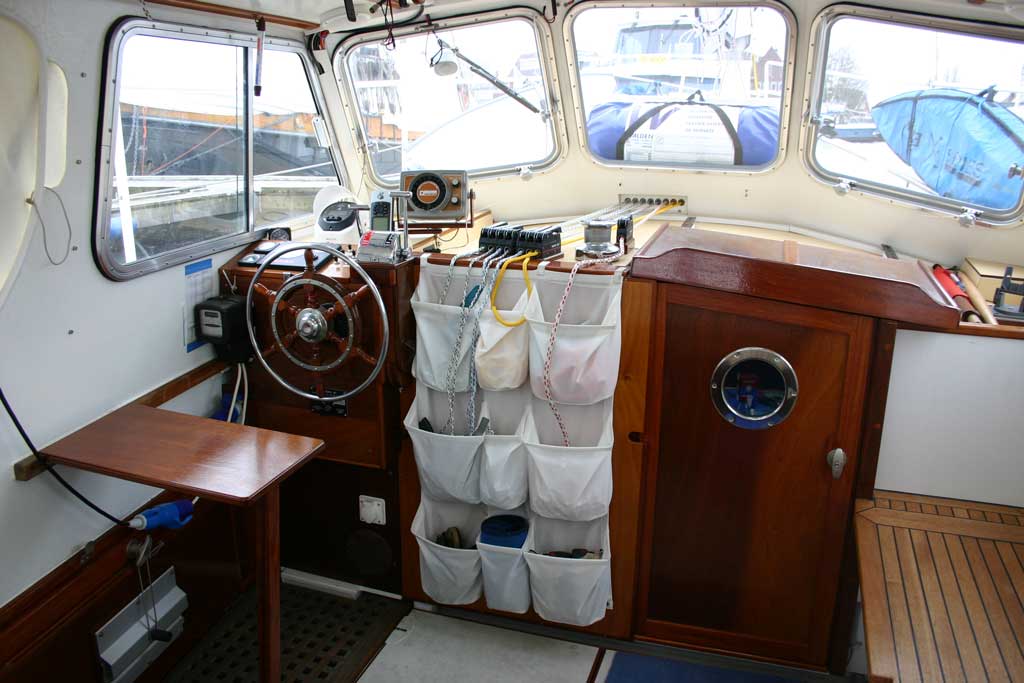
new cockbit
Storing bicycles and a dinghy
A waterproof aluminium box is located on the foredeck and stores our bicycles and many other useful things. We choose the folding ‚Banana‘ boat for our dinghy; this is stored on the starboard rail. A small crane lift, connected to the tabernacle, helps launching and hoisting the dingy back on deck. With this crane even Ursula can hoisting the dingy on deck without anyones help.
Starting a new life on PRÜVEDA
After nearly seven years of construction and building, we quitted our jobs and our rented flat and moved for several months on board before launching the boat. It was a good exercise to find out, how life would be on PRÜVEDA. We tested the working areas, thousands of items went on to the boat. Finally every little thing found its best place. The interior was now complete and PRÜVEDA was ready for transport.
The launching took place in Basel (the Swiss Seaport) into the River Rhine on 2nd of August 2005. Four days later we left Basel and moved down the river Rhine to Holland. In the Ijsselmeer we put up the mast and PRÜVEDA was ready to sail for the first time with a light wind, it was an unforgettable moment. A few days later our first real sailing came with force 4-5 in the Ijsselmeer with choppy waves, as is typical here. Let’s just say that we got out and buck. Everything was new, the heeling and the movement of the boat, and we found out that the keep battens we had used were not strong enough. We still have a lot to learn on how to handle our Junk Rig in different situations and without doubt there will be many improvements we will have to make. In the meantime we have had wonderful cruising with beautiful weather.
For the wintertime we have found a friendly yacht harbour at the end of the old Ems Channel in Delfzijl near the German border. We have been living now for 10 month on PRÜVEDA and we enjoy our swimming home very much. In spring 2006 we are looking forward to exploring the Wattensee and its German Islands. After crossing the North Sea, Baltic Channel and sailing along the East coast of Denmark, we are planning to head towards the Swedish West coast and the South coast of Norway. Our big aim is to arrive in Stavanger next August 2006, to meet some JRA Members at the JRA Rally.
2. Junk Rig Association Members news January 2007 Newsletter 48
Wolfgang and Ursula of Prüveda missed the Norway rally but made up for it by meeting IVORY GULL and LINDA and later in Grena met Jo and Do Schaeuble and dog Kuro on board GOLDEN WIND. Now they are in Germany heading south for the sun.
